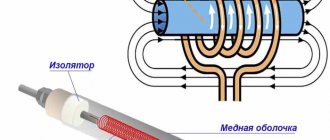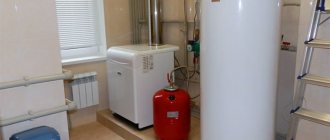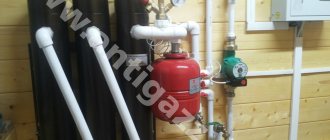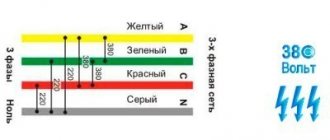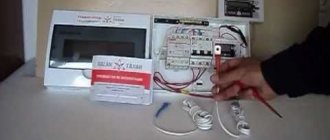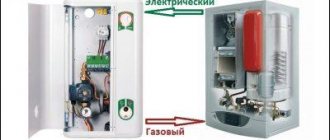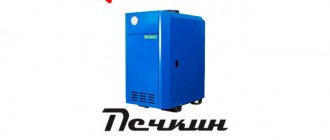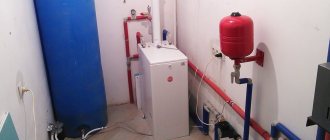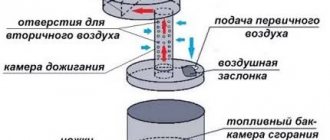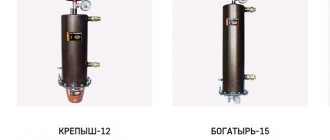Electric boilers for heating are actively used by owners of private houses not connected to the gas main.
The units have a simple design, high efficiency and productivity.
They differ in the power with which they can heat a specific area of the room.
In this article you can find out what electric boilers are for heating a house of 60 square meters. m.
What models have become popular and how to choose the ideal option.
Types of electric boilers
Manufacturers supply the following devices, similar in operating principle:
- Equipped with heating elements. A tungsten spiral is located in a special housing filled with quartz. When current is passed through the wire, the wire becomes heated. The resulting heat increases the temperature of the circulating fluid inside the tank. Next, the water enters the system (pipes, radiators) and returns to the tank.
- Electrode. The zero phase is connected to the cylindrical body. There is an electrode inside. The undistilled liquid that circulates through the tank has resistance. And when the current passes through the water, the coolant heats up.
- Induction. The tank contains a coil wrapped with a cable, inside of which there is a metal rod. When the current moves, vortex flows arise and the water heats up.
How to choose?
When choosing, you should take into account the power and type of unit . So a house with an area of 60 sq. m are capable of heating devices with a power of 4 to 18 kW. The more powerful they are, the faster the rooms warm up, and the higher their cost.
Today, manufacturers offer 3 types of electric heating boilers.
They differ from each other in design, advantages, additional features:
- Heating element boilers . The heating element in the form of plates or tubes acts as a heating element. It is housed in a heat exchanger. One device can be equipped with 8 2 kW elements. Adjustment occurs automatically or manually. Such models are presented on the market in the form of single-circuit and double-circuit products. They operate on water, antifreeze or oil. Double-circuit ones additionally heat a container of water for its subsequent use in domestic needs. But heating element boilers have low efficiency due to the stepped water heating system - 80-93%.
- Electrode boilers . Heating elements - electrodes. Water acts as an excellent electrolyte with a given resistance. When it passes through a salty environment, heating occurs. They are characterized by simple, high efficiency - 94-95%, simplicity and safety. Disadvantage - they require frequent replacement of electrodes due to their rapid dissolution in a salty environment.
- Induction boilers . Complex systems involve induction coils in the form of wire wound around a dielectric. Electric current passes through the coil, forming electromagnetic induction. After its influence on the potential difference, the core is heated. The efficiency is 99%, energy savings are observed, and a comfortable temperature in the room is maintained for a long time.
The buyer decides which type of boiler to choose. The main thing is to pay attention to power consumption and output .
Advantages and disadvantages
The advantages of electric boilers include:
- practically do not make any sound during operation;
- easy to install, and operation does not require special knowledge (just read the manufacturer’s instructions);
- no chimney or ventilation required.
Since the devices do not emit harmful combustion products, they are considered environmentally friendly equipment and are installed even in rooms that have special requirements (for example, in laboratories).
The only drawback of such equipment is that a constant supply of electricity is required. If in the city failures with the latter rarely occur, then in the periphery such a problem is typical.
What material are boiler heat exchangers made of?
Once you have decided on the type of fuel and type of boiler, you need to pay attention to the design features and operational characteristics.
An important parameter is the type of material from which the heat exchanger is made. There are only two basic and widespread options :
- cast iron;
- steel.
Cast iron heat exchangers are more durable, their useful life is more than twenty years, and they are resistant to corrosion. But this material is quite sensitive to mechanical stress and temperature changes, which can lead to deformation of the structure. Cast iron boilers consist of modules and sections, which facilitates transportation and installation.
This is an excellent solution for solid fuel wood boilers. But this is not a very good solution for automatic solid fuel boilers, since these boilers operate in start-stop mode, which leads to frequent temperature changes, and this adversely affects cast iron. In addition, a cast iron heat exchanger requires frequent cleaning, and it is not very convenient to clean, unlike a steel one.
Steel heat exchangers are more resistant to temperature changes and mechanical damage, but their useful life is slightly shorter.
This solution is perfect for appliances operating on hard and brown coal. Steel boilers are welded from fragments of sheet steel; this is a non-demountable structure.
Much less common materials for heat exchangers are copper, ceramic-coated steel, or combined solutions.
Installation Rules
When installing equipment, the following aspects are observed:
- the device body must be grounded;
- connection of units with heating elements is carried out through an RCD, with electrodes and induction coils - using separate automatic devices and a power supply panel;
- the cable material and cross-section are checked, since the manufacturer indicates this data on the equipment.
It must be remembered that the connection of units is carried out exclusively by a specialist. According to SNiP, liability in the event of an emergency lies with the person who performed the installation. However, you are allowed to carry out other work yourself - fastening pipes, radiators, etc.
Complete set of heating units
We have already listed the elements of any electric boiler in the basic, cheapest configuration. This is a heating unit, thermostat, automation with an actuator, controls and a temperature sensor.
An important nuance. In budget versions of boilers, the executive element is a magnetic starter. It clicks loudly when the heating is turned on, the sound is clearly audible in the rooms adjacent to the boiler room.
In an extended configuration, manufacturers supply electric boilers with the following equipment:
- low-noise modular contactor instead of a magnetic starter;
- circulation pump;
- membrane expansion tank for a closed heating system;
- overheating and coolant pressure sensors;
- safety group – automatic air vent, safety valve;
- circulation sensor – for induction heat generators;
- weather automatics;
- LCD display, programmer, GSM remote control module from a smartphone.
Tips and tricks
Before choosing a boiler for heating a private home, you need to decide for what purpose the equipment is being purchased. If additional hot water supply is required, it is recommended to purchase a dual-circuit unit.
They also take into account where the device will be placed - on a horizontal or vertical surface. In the latter case, the boiler must be securely mounted on the wall (a plasterboard partition, for example, will not work).
They also look at the presence of automatic functions, whether there is a circulation pump, a remote control, pay attention to electricity consumption, etc. Often the boiler is selected to fit into the overall interior.
TOP 8 electric boilers for 60 square meters
Each electric boiler is the product of painstaking work of professional engineers and craftsmen. The following are popular models from global manufacturers. They were able to prove their effectiveness in a work environment.
EVAN Warmos-IV-9.45 9.45 kW
Wall-mounted model in a compact case. The boiler is designed for operation in residential premises and industrial areas. Equipped with wear-resistant heating elements with three-stage power adjustment.
Peculiarities:
- maintaining optimal temperature;
- single-circuit design;
- possibility of functioning in tandem with non-freezing liquids;
- quiet operation;
- presence of a self-diagnosis system.
Characteristics:
- belongs to the single-circuit type;
- Max. power - 9.45 kW;
- Max. area - 94.5 sq. m;
- Efficiency - 99%;
- equipped with electronic control, display, auto-diagnosis, protection against freezing and overheating, connection of a heated floor, power-on indication, thermometer;
- mains voltage is three-phase with a rated current of the circuit breaker of 25 A;
- temperature of heating elements - 5-85°C;
- service life - 10 years;
- manufacturer's warranty - 2 years;
- dimensions - 380x640x245 mm;
- weight - 27 kg.
Advantages:
- the boiler independently selects the number of power stages to maintain the set temperature. It is also possible to adjust the power manually;
- maintaining operability if a sharp decrease or increase in voltage is observed;
- if the unit overheats too much, the auto-shutdown system is triggered;
- the ability to connect the unit to remote control via Wi-Fi or GSM channel;
- heat loss is minimized;
- durability, strength and attractive design;
- cost - from 18,000 rubles.
Flaws:
- The boiler requires the installation of an additional water heater to produce hot water.
EVAN Next 7 7 kW
It looks like a monoblock, the design of which consists of a boiler and a control panel . The wall-mounted model with three-stage power adjustment is designed for installation in any type of room.
It can be used as a stand-alone unit or acts as an addition to heat-solid equipment.
Characteristics:
- belongs to the single-circuit type;
- power - 2.33-7 kW;
- heated max. area - 70 sq. m;
- Efficiency - 99%;
- control - mechanical;
- mains voltage - single-phase or three-phase;
- coolant temperature - 30-85°C;
- presence of an overheating protection system;
- service life - 10 years;
- warranty - 2 years;
- dimensions - 205x600x105 mm;
- weight - 8 kg.
Advantages:
- compact dimensions;
- high build quality;
- The heating elements are made of stainless steel, which affects their durability;
- ease of installation and maintenance. A 1″ pipe is required for connection;
- quick heating of rooms with long-term maintenance of the set temperature;
- attractive price - from 8,000 rubles.
Flaws:
- not detected.
EVAN EPO 6 6 kW
This is the most budget-friendly electric boiler, perfect for floor installation in the house or country house . A distinctive feature is the absence of a case, but the preservation of all basic characteristics and capabilities.
Additionally, it is possible to connect an external thermostat to regulate the temperature. For example, the GSM-Climate remote control module.
Characteristics:
- type - single-circuit;
- Max. power - 6 kW;
- Max. area - 60 sq. m;
- Efficiency - 99%;
- availability of electronic control, remote control, power-on indication, overheating protection, connection of external control;
- mains voltage - single-phase;
- coolant temperature - 30-85°C;
- service life - 10 years;
- warranty - 2 years;
- dimensions - 160x500x200 mm;
- weight - 7 kg.
Advantages:
- durability of the heat exchanger, thanks to its manufacture from stainless steel;
- light weight and compact dimensions make it easy to install and maintain the unit;
- highest level of safety in case of boiler overheating;
- possibility of connecting a “warm floor” system;
- affordable price - from 9,000 rubles.
Flaws:
- not found.
ZOTA 9 Lux 9 kW
Wall-mounted model with three-stage power helps reduce heating costs by maintaining a minimum safe temperature.
At the same time, the room heats up quickly and evenly. This is the third generation of electric boilers, which are equipped with control unit protection against power surges.
They are also suitable for connection to a “warm floor” system.
Characteristics:
- belongs to the single-circuit type;
- power - 3-9 kW;
- area - 90 sq. m;
- the presence of electronic control, outdoor temperature sensor, room thermostat display, auto diagnostics, protection against freezing and overheating;
- network voltage - single-phase and three-phase;
- heating element temperature - 30-90°C;
- Max. water pressure - 6 bar;
- dimensions - 290x730x160 mm;
- weight - 18 kg;
- warranty - 1 year;
- cost - from 19,000 rubles.
Advantages:
- simplified access to the heating element block;
- the heaters are made of a stainless tube with a diameter of 7.4 mm, which allows you to quickly replace them using a regular wrench;
- the presence of ultra-precise sensors;
- ease of management of functions and capabilities;
- emergency situations are accompanied by characteristic sounds;
- ability to save individual settings.
Flaws:
- Requires professional installation.
EVAN Next 3 3 kW
The wall-mounted design with three-stage power is ideal for heating any type of room . Used as a main or backup heat source.
This is an economical, ergonomic, easy to install and operate model . The combination of reliability and low price makes the unit the best in its class.
Characteristics:
- type - single-circuit;
- power - 1-3 kW;
- area - 30 sq. m;
- Efficiency - 99%;
- equipped with mechanical control, overheating protection;
- mains voltage - single-phase or three-phase, with a rated current of the automatic switch 16 A or 6 A;
- coolant temperature - 30-85°C;
- service life - 10 years;
- warranty - 2 years;
- dimensions - 205x600x105 mm;
- weight - 8 kg.
Advantages:
- silent operation;
- high level of reliability and quality, efficiency in completing assigned tasks;
- The heating elements are made of stainless steel, which makes them durable and economical;
- ease of installation, replacement of main components;
- affordable price - from 7,000 rubles.
Flaws:
- there are no negative sides.
Vaillant eloBLOCK VE 9 9 kW
Wall-mounted model with two-stage power with more advanced features . It features a modern design, microprocessor control and eBus, simple and convenient controls, smooth power changes with moderate load.
Characteristics:
- type - single-circuit;
- power - 3-9 kW;
- Efficiency - 99%;
- has electronic control, a built-in circulation pump and a 10-liter expansion water tank, a display, autodiagnostics, protection against freezing and overheating, a thermometer, a pressure gauge, a power-on indication, and protection against pump blocking;
- mains voltage - single-phase or three-phase (14 A or 16 A);
- coolant temperature - 25-85°C;
- dimensions - 410x740x310 mm;
- weight - 32.9 kg;
- service life - 10 years;
- warranty - 2 years.
Advantages:
- the ability to connect external control;
- ease of installation due to the presence of a 3/4″ pipe;
- durability and strength;
- rapid heating of rooms with long-term maintenance of the set temperature;
- the model provides for the connection of a “warm floor” system;
- there is an air vent.
Flaws:
- high price - from 37,000 rubles. However, it is justified by the highest quality.
Reko 6P 6 kW
Wall-mounted, attractive model with three-stage power . It is distinguished by the presence of functions: protection against freezing and overheating, connection to a “warm floor”, programmer, power-on indication, thermometer.
It is possible to connect external control for better comfort.
Characteristics:
- single-circuit type;
- power - 2-6 kW;
- area - 60 sq. m;
- mains voltage - single-phase or three-phase;
- carrier temperature - 10-85°C;
- connection - 1″ pipe;
- dimensions - 300x500x195 mm;
- weight - 12 kg;
- service life - 5 years;
- warranty - 2 years.
Advantages:
- convenient and simple functionality;
- silent operation of the unit;
- the ability to use individual settings;
- durable heating elements;
- uniform and rapid heating of rooms;
- low price - from 18,000 rubles.
Flaws:
- not identified.
ZOTA 6 Economy 6 kW
The wall-mounted model with three-stage power is popular due to its low cost, but the presence of impressive functionality.
It has electronic control, connection to a “warm floor”, power indicator and overheating protection. The durability of the heating elements is achieved by making them from stainless steel.
Characteristics:
- single-circuit tee;
- power - 2-6 kW;
- area - 60 sq. m;
- mains voltage - single-phase or three-phase;
- coolant temperature - 40-90°C;
- Max. water pressure - 6 bar;
- connection pipe - 1 ¼";
- dimensions - 185x460x120 mm;
- weight - 5.5 kg;
- warranty - 1 year.
Advantages:
- good value for money. The buyer receives a powerful product for only 9,000 rubles;
- compact dimensions and low weight allow you to install the boiler without much effort;
- the unit does not spoil the wall finish;
- uniform supply of hot air into the room, with efficient heating.
Flaws:
- The boiler can be connected using the EVT-I1 PU panel, which is not included in the kit.
Electric boilers for heating a house of 60 sq. m - modern and multifunctional designs .
They not only cope with the assigned tasks, but also harmoniously adapt to the overall interior of the room. Affordable prices and attractive service life make such units a profitable purchase.
Finally, about energy consumption
The natural desire of a homeowner is to know how much electricity an electric boiler will consume when heating a private home. Unfortunately, actual consumption cannot be predicted. The indicator is too individual and depends on a number of factors - the degree of insulation, the temperature maintained inside, the weather.
Monthly consumption can be calculated approximately: take 50% of the estimated heat loss of the house, multiply by 24 hours and 30 days. Example: losses are 6 kW, half - 3 kW, per day 3 x 24 = 72 kW, per month - 72 x 30 = 2160 kW. Why we take ½ power: during the season the weather is not always cold, the warmer it is outside, the more often the electric boiler turns off.
An example from personal experience. A house of 100 m² is heated at night with a 9 kW electrode boiler for 8 hours, the region is southern. Over 6 months of the heating season, the electric boiler consumed 9104 kW. Average monthly energy consumption is 1517 kW, average daily energy consumption is 1517 / 30 = 50.6 kW.
DIY electrode boiler drawings
Before you begin manufacturing, you should take into account that the lion's share of the price of the electrode installation falls not on the heater itself, but on the electronic control system, the pump that circulates the coolant and other components, which are unlikely to be made at home. Well, for those who still decided to try their hand, below are step-by-step instructions.
- A coupling is screwed onto one end of the pipe, which will act as an outlet pipe.
- A tee is screwed on from the other end to provide coolant supply.
- A plug is made from durable textolite or other dielectric to ensure the electrode is fixed in the center. To make the electrode itself, you can use a steel rod with a diameter of 10-12 mm. After installing the rod, the plug together with the electrode is screwed into the tee.
- Two M8 bolts are welded to the pipe, which will serve as the neutral wire and grounding terminals.
- The device is connected to the heating circuit through the coupling and the free end of the tee.
Particular attention should be paid to sealing threaded connections and grounding arrangements.
Modern electrode heating boilers are distinguished by their simplicity of design, reliability and long service life and can easily compete with solid fuel and gas boilers. Using electricity allows you to avoid both the tedious preparation of firewood or coal and the construction of chimneys.
